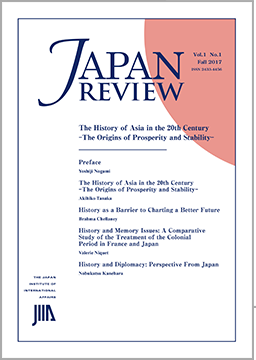Column/Report
|Top page|Print/Mobile page|Tweet
JIIA Strategic Comments(No.1):
US told Russia It Is Leaving INF Treaty: Possible Impacts on the Asia-Pacific Security
Hirofumi Tosaki, Senior Research Fellow
Miho Okada, Research Fellow
Hironori Fushita, Research Fellow
On October 21, 2018, US President Donald Trump announced that the US would withdraw from the Intermediate-range Nuclear Forces (INF) Treaty obliging the US and Russia to eliminate all ground-launched ballistic/cruise missiles with a range of 500 to 5,500km (hereinafter, “intermediate-range missiles”). On October 22-23, US National Security Advisor John Bolton visited Moscow and met with President Vladimir Putin, Secretary of the Security Council of Russia Nikolai Patrushev, and Russian Minister of Foreign Affairs Sergei Lavrov. Although it was reported that the two sides had agreed to a US-Russia summit meeting on November 11, Bolton stated that a formal notification on withdrawing from the treaty would be filed “in due course”. Any withdrawal from the INF Treaty would go into effect six months after notification to the other state party.
Trump and Bolton have cited, as the reasons for withdrawing from the treaty, ongoing violations by Russia, the other party to this bilateral agreement, as well as the heightened threat posed to the US by the upgrades made to intermediate-range missiles by China, which lies outside the INF Treaty framework. In 2014, the US officially asserted that Russia had developed and test-launched the 9M729/SSC-8 ground-launched cruise missile (GLCM) in violation of the INF Treaty, and indicated that it was considering all options in response, with one of these options being withdrawal from the INF Treaty.
However, critics of such a withdrawal have expressed serious doubts that abrogation of the INF Treaty and re-deployment of intermediate-range missiles would serve the security interests of the US. Firstly, they argue that the US does not need ground-launched intermediate-range missiles in addition to the currently deployed conventional sea-launched cruise missiles (SLCMs) as well as air-launched cruise missiles (ALCMs) with nuclear or conventional warheads. As for ALCMs, the Long Range Stand Off (LRSO) is also under development for replacing them. Secondly, there is a serious question of where such ground-launched missile could be deployed. In its Nuclear Posture Review (NPR) released in February 2018, the US named Russia, China, North Korea and Iran as major targets of its deterrence posture. However, placing these countries within range of its intermediate-range missiles would require that these missiles be deployed in the territories of its European and Northeast Asian allies (except for Guam, located 4,000km from Beijing), whose acceptance of such deployment would by no means be certain. This is why the NPR seeks to plug the gaps in US nuclear deterrence capabilities at the theater level by advocating the development of low-yield warheads for submarine-launched ballistic missiles (SLBMs) or nuclear SLCMs that do“ not require or rely on host nation support to provide deterrent effect.”
On the other hand, Russia, which lies directly exposed to the intermediate-range missiles developed and deployed by China and other neighboring countries in the Middle East and South Asia, has expressed a strong sense of frustration that only Moscow (and Washington) is bound by the INF Treaty. Russia asked the US to jointly sponsor a proposal that the INF Treaty be made multilateral. However, the US-Russian proposal at the October 2007 UN General Assembly did not garner a favorable response from other countries, especially from those countries possessing intermediate-range missiles. Shortly thereafter, Russia began development on a missile deemed by the US in violation of the INF Treaty. For Russia, the heightening of tensions with the US and the NATO over relations with former Soviet republics as well as the installation of the US missile defense systems in Poland and Romania seem to have made intermediate-range missiles capable of reaching NATO countries an even greater priority.
Russia must also give due consideration to its missile balance vis-à-vis China. Although Russia and China have enjoyed good relations in recent years for their common interest of balancing the US, the two countries have historically been at odds, and Russia is not likely welcoming the rise of China with open arms. This is because China’s agressive modernization of its nuclear and conventional forces could push Russia into a disadvantageous position over the medium to long term. In particular, Russia has become increasingly unhappy that China, as a non-signatory to the INF Treaty, is openly building up its arsenal of intermediate-range missiles, while Russia is banned from possessing such missiles under the treaty (a point viewed as problematic by the US as well). Once the INF Treaty is lapsed, Russia will be able to legally redeploy intermediate-range missiles capable of countering China, an option that may not be a bad one for Russia.
However, the disadvantages that termination of the INF Treaty would bring to Russia cannot be ignored. Firstly, there still exists a possibility that the US will redeploy intermediate-range missiles in Europe despite the key European allies’ opposition to the US withdrawal from the INF Treaty, and uncertainty over their acceptance of these missiles on their soils. Secondly, Moscow may concern about the impacts of the INF Treaty issues upon the New Strategic Arms Reduction Treaty (New START), which forms a key element of Russia’s belief that it ranks alongside the US as a nuclear superpower. Moscow has proposed that the New STRAT be extended beyond its February 2021 expiration, but Washington is likely to reject this extension unless the Russian violation of the INF Treaty is resolved, making it possible that New START will lapse as well. Thirdly, Russia has deployed a considerable number of SLCMs and ALCMs over the past several years, whose effectiveness has been demonstrated in military operations in Syria. Since Russia is now capable of putting neighboring countries within the ranges of its non-ground-launched intermediate-range missiles, the majority opinion in the Russian government and the Federal Assembly is that it would be inappropriate to allow the INF Treaty to lapse.
In view of the situations mentioned above, it might not be unthinkable that the US announcement to withdraw from the INF Treaty will trigger serious discussions aimed at resolving Russia’s non-compliance with the treaty and thereby avoiding abrogation of the treaty. At the same time, the US announcement has once again highlighted the two countries’ shared concern on the fact that the INF Treaty prohibits only the US and Russia from possessing intermediate-range missiles, even as China and other countries have stepped up their development and deployment of such missiles. This would inevitably lead them to the question whether the INF Treaty be kept alive in its original form and, if not, what other options are available. As noted above, the US has pointed to the Chinese threat as one reason for withdrawing from the INF Treaty, and that point will certainly become another focus of discussions on the future of the treaty. Consideration must be given to the possibility that, as a result of such discussions, the US and Russia allow the INF Treaty to lapse while at the same time propose a new arms control framework that includes China.
In such a case, one issue Japan will need to seriously consider is that of a Northeast Asian version of the “double-track decision” that has been proposed on some occasions. Just as NATO’s “double-track decision” during the Cold War served as the catalyst for the conclusion of the INF Treaty, the possibility cannot be excluded that a policy pursuing intermediate-range missiles deployment in the Asia-Pacific region might be put forth in order to bring China to the table for arms control negotiations. While such a policy could be one means of inhibiting China’s buildup of intermediate-range both ballistic and cruise missile arsenal, it could also increase tensions with China, even if only temporarily. Long-term perspectives and strategic thinking will be required for resolving this difficult challenge at the crossroads of deterrence and arms control.
Japan played a key role in the INF Treaty negotiation process in the 1980s. It was initially proposed that all intermediate-range missiles in Europe be eliminated, which gave rise to the prospect of Soviet SS-20 intermediate-range ballistic missiles being redeployed to Siberia and the Russian Far East. With tenacious diplomatic efforts by Japan, however, the goals of the “zero option,” that is, the global elimination of the US/Soviet intermediate-range missiles, were achieved. Now in the 21st century, incorporating China into the arms control regime for intermediate-range missiles is both an issue directly tied to Japan’s security and an important step toward a total elimination of nuclear weapons. It cannot easily be predicted what sorts of proposals will be forthcoming from the US and Russia and whether China will find them acceptable. Still, in view of how extremely important these issues are for Japan, it is vital that Tokyo become pro-actively involved as it was in the 1980s.
(2018-10-25)
Topics
Membership
 Archive of high-quality scholary works translated from Japanese to English
Archive of high-quality scholary works translated from Japanese to English
A highlight of JIIA's recent activities and a summary of its organization.
Publication
Journal

Kokusai Mondai (International Affairs)
No.680 April 2019 "Protecting Human Rights via International Procedures"
Vol.2 No.4 Spring 2019
"Japan and the Post-World War II Liberal International Order"
Books
 What Do Alliances Mean to the US?
What Do Alliances Mean to the US?
(Fumiaki Kubo ed., 2013)






